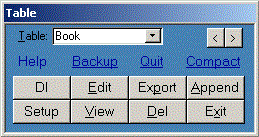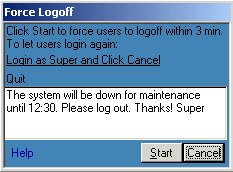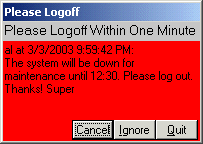tbinv.com
Table Form
Edit, export, append, merge, view or delete tables
 To open the form:
To open the form: Click Table on the Main form.
To find a table: Select from the Table combo box or PgDn to a table.
You can maintain the following tables: Book, BookType, Budget, Class, Course, CourseBook,
School, Student, StudentClass, Subject, Teacher, Transfer or Vendor. The Setup and User
tables can only be edited.
Click the
Backup link to copy the back-end database (tables) to another file. The
default is c:\ageesw\TBDymmdd.MDB where y is the year, mm is the month and dd is the day.
If the file exists, it is overwritten. Other users can remain in the system while this backup
is done.
To compact the back-end database, click the
Compact link. As users use the database,
the back-end database can become fragmented and use disk space inefficiently. Compacting
the database makes a copy of the database, optimizing indexes, queries and file storage.
No other user can use the database for the minute or so it takes to compact it. Use the
Quit link to gently force users off the system and gain exclusive access if necessary.
When you click the Compact link and answer Yes, you will be asked for
your password and then the database will close. When the application closes, users can login
and continue normal operations. You should compact the database about once per week.
To force all users out of the system for compacting or other maintenance, click the
Quit link.
Enter a short message telling the users when they can go back to work and click Start. Within a minute, the forms on
each user's screen will turn red and your message will appear. Within another minute, all users
will be forced to quit. Only Super users can login while in the Quit mode.
IMPORTANT:
When you are done performing maintenance, login as a super user and click Table, Quit, Cancel
to allow others to login to the system again.
Click
Edit to open a form to update the selected table.
Click
Export to save the selected table as CSV (comma separated values), DBF (dBase),
RTF (Wordpad or Word), TXT or XLS (Excel) format.
Click
Append to add records from a CSV, DBF or XLS file or a table in an Access MDB.
Enter the filename to append from. It is better to import from MDB or XLS tables because the
field names must match exactly. DBF field names are limited to 10 characters and CSV import
ignores field names so field position is extremely important. Each table has a primary
key field that uniquely identifies each record. If a primary key value is duplicated in the imported
data, that record will be ignored. If the primary key is an autonumber field, the receiving
table assigns the value. All appended records are timestamped and marked with your userid.
Caution: Always make a backup and plan carefully before appending. If key fields are changed,
you may lose links to related tables. For example, if you change the CourseID in the Course
table, append does not change CourseIDs in the Class table. You can use Del to delete the new records
in that table if you need to undo the append.
Click
View to see the selected table (read only) or any CSV, DBF or XLS table
or Access table in an MDB database. The default file is the application's back-end (tables) database.
Using the Access menu, you can rearrange columns, sort, find or select rows to print or export
to email. You can also view special queries used by the Import routine: iClass, iStudent, iStudentClass,
iTeacher, iqClass, iqStudent and iqTeacher.
Click
Import to merges records from your district's student system. This process is custom written
for each district. An unsecured external database, usually c:\ageesw\imp.mdb (specified on the Setup form)
on the server, links to tables on the district student system. If you use Student level
accountability, when you click Import, data is copied into imp.mdb. You can View this data
as iClass, iStudent, iStudentClass and iTeacher. After you close imp.mdb, those queries are
converted to TBInv structure (iqClass, iqStudent, iqTeacher) and Merged. Student and Teacher
counts are recalculated. If you use Teacher or School accountability, you will merge StudentCount
instead of Student and StudentClass data.
Click
Del to delete records from the selected table. Enter a start and end date/time. All records
with UpdDate within the range will be deleted. The default is to delete only the current day's records.
Close
Sitemap To open the form: Click Table on the Main form.
To find a table: Select from the Table combo box or PgDn to a table.
You can maintain the following tables: Book, BookType, Budget, Class, Course, CourseBook,
School, Student, StudentClass, Subject, Teacher, Transfer or Vendor. The Setup and User
tables can only be edited.
Click the Backup link to copy the back-end database (tables) to another file. The
default is c:\ageesw\TBDymmdd.MDB where y is the year, mm is the month and dd is the day.
If the file exists, it is overwritten. Other users can remain in the system while this backup
is done.
To compact the back-end database, click the Compact link. As users use the database,
the back-end database can become fragmented and use disk space inefficiently. Compacting
the database makes a copy of the database, optimizing indexes, queries and file storage.
No other user can use the database for the minute or so it takes to compact it. Use the
Quit link to gently force users off the system and gain exclusive access if necessary.
When you click the Compact link and answer Yes, you will be asked for
your password and then the database will close. When the application closes, users can login
and continue normal operations. You should compact the database about once per week.
To open the form: Click Table on the Main form.
To find a table: Select from the Table combo box or PgDn to a table.
You can maintain the following tables: Book, BookType, Budget, Class, Course, CourseBook,
School, Student, StudentClass, Subject, Teacher, Transfer or Vendor. The Setup and User
tables can only be edited.
Click the Backup link to copy the back-end database (tables) to another file. The
default is c:\ageesw\TBDymmdd.MDB where y is the year, mm is the month and dd is the day.
If the file exists, it is overwritten. Other users can remain in the system while this backup
is done.
To compact the back-end database, click the Compact link. As users use the database,
the back-end database can become fragmented and use disk space inefficiently. Compacting
the database makes a copy of the database, optimizing indexes, queries and file storage.
No other user can use the database for the minute or so it takes to compact it. Use the
Quit link to gently force users off the system and gain exclusive access if necessary.
When you click the Compact link and answer Yes, you will be asked for
your password and then the database will close. When the application closes, users can login
and continue normal operations. You should compact the database about once per week.

